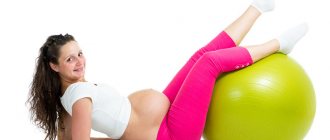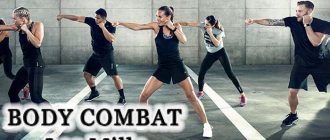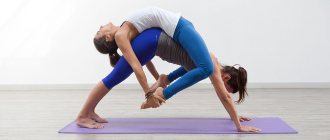Changes in the body during pregnancy
In the very early stages of pregnancy, physiological changes begin in the body at different levels. First of all, hormonal, the active production of hormones promotes stretching of the ligaments of the uterus, pelvis, and promotes changes in the entire skeleton.
In the body of pregnant women, the “main” organ is the uterus. During active growth, it displaces organs and the spinal column. In response to this, the body aligns itself around the uterus, creating conditions for the development of the fetus.
The most visible changes occur in the second and third trimester: • Figure of a chess knight Active growth of the fetus contributes to a deepening of the lumbar lordosis, and an increase in thoracic kyphosis, the head and sacrum lean forward. Such changes are caused by a change in the center of gravity to be able to maintain a vertical position. • Load on the muscles To support the growing fetus and uterus, the muscles of the back, diaphragm and abdominal wall experience enormous stress. An additional aggravating factor is the displacement of internal organs, and all this causes overstretching of the muscles of the anterior abdominal wall. • Opening of the pelvis In a pregnant woman, the pelvis is described as a flower, which is necessary for the fetus to pass through the birth canal. But if the posture is poor, there is scoliosis, or asymmetry of the pelvic bones, then the opening occurs unevenly. What's the result? Chronic pain and discomfort. • Symphysis The pubic bones are connected to each other by cartilaginous tissue - the symphysis. Normally, its width is 5 mm; during pregnancy, due to the production of relaxin, it expands. But if it is too strong, problems are formed, namely symphysitis, which is characterized by severe pain, changes in gait, etc. • Pelvic floor muscles This is a muscular-fascial septum and during gestation they experience a large load, and then overstretch during childbirth. This can cause pelvic floor muscle incompetence.
By the way, one of the main tasks of the recovery period is the prevention of pelvic floor dysfunction.
Stretching
Stretching is also one of the weight loss exercises for pregnant women at home.
Exercising helps maintain body flexibility, increase muscle elasticity, and reduce the burden of weight gain.
Unlike other training sets that are recommended to be emphasized in the first and second trimester, stretching will help more in the final stage of the “standby mode”.
Leg stretching exercises prevent perineal tears during childbirth.
Pelvic floor muscle dysfunction is a common problem.
Unfortunately, this is a fairly common problem that can be identified not only in pregnant women, but also before its onset. Obvious signs of incompetence will be: • frequent urination, a feeling of an incompletely emptied bladder. Some women note that after just a couple of minutes they want to go to the toilet again; • queefing – the entry of air into the vaginal canal after sexual intercourse, with a corresponding sound after or during its completion; • incontinence and urine leakage during exercise, laughing, coughing or sneezing; • irregular bowel movements, feeling of incomplete bowel movement; • pain in the perineum after sexual intercourse; • dissatisfaction with sex life.
If such symptoms were noted before pregnancy, the help of a specialist is necessary. Exercise will help get rid of complications, and childbirth will be easier.
Criteria for the effectiveness of classes
The duration of a standard aerobic workout, including warm-up and cool-down, ranges from 45 to 60 minutes. The criterion for the effectiveness of aerobics is the value of heart rate (heart rate) during physical activity.
It is generally accepted that during aerobic exercise the recommended heart rate (HRR) should be between 65 and 85% of your maximum rate. That is, its lower limit will be 65%, and its upper limit will be 85%.
Only in this case will training be considered effective in a healthy person. To calculate your maximum heart rate (MPR), you can use a simple formula: 220 minus age.
Therefore, the lower limit of the RFI will be 65% of the MPP, and the upper limit will be 85%. To determine heart rate during exercise, it is necessary to measure the pulse at the wrist or carotid artery.
You can also use special heart sensors, for example, which will monitor your heart rate and report if it goes beyond acceptable limits.
Attention! Intense aerobic exercises during pregnancy are not recommended for people with severely high or low blood pressure, congenital and acquired diseases of the heart, blood vessels and lungs, as well as injuries to the ankle, knee joints or spine.
Physical activity and sports during pregnancy
Is it possible to play sports in a position? Definitely yes, but under the guidance of a specialist who will evaluate the pros, cons and possible consequences. All permitted exercises and the degree of load are determined by several components: initial physical fitness, gestational age, characteristics of the course of pregnancy, etc. Even if the pregnancy is proceeding ideally, and the woman herself led an active sports life. You can continue training, but make adjustments to reduce their intensity by 30-50%. And it is important not to start new types of training. The situation is more complicated with women who are far from sports and physical activity was reduced to going to the store or to work.
Movement instructors at the Quality of Life clinic will not only keep you in excellent shape, but will also select an adequate load to solve existing problems and prevent complications.
Contraindications
Sometimes aerobics is contraindicated. Contraindications can be relative or absolute . For the last category, any physical activity is contraindicated.
So, aerobics is prohibited in the following cases:
- If there is placenta previa.
- The membranes have ruptured.
- There is a risk of premature birth.
- A history of several abortions.
- Miscarriages before an existing pregnancy.
- Multiple pregnancy.
It is possible to coordinate exercises with a doctor if you have the following diseases:
- Hypertension.
- Arrhythmia.
- Anemia.
- Diseases of the endocrine system.
- Diabetes.
- History of fetal failure or premature birth.
Gymnastics for pregnant women: benefits
All exercises that are selected for pregnant women are not aimed at preventing possible and existing problems. By following a course under the guidance of an experienced and compassionate specialist, it is possible to achieve the following goals: • Maintain posture During pregnancy, weight gain always occurs, which puts additional stress on the musculoskeletal system and muscles. And if the muscles are not trained, they cannot fully cope with the load, which causes corresponding problems. Gymnastics allows the body to better adapt to increasing loads, as well as a shift in the center of gravity. • Reducing stress levels Gestation is a magical time, full of anticipation and plans, but there can still be unpleasant moments that can cause stress. Considering the fact that physical exercise promotes the production of endorphins, this is an excellent prevention of stress and depression (even in the postpartum period). • Normalization of blood circulation Normalization of blood circulation is a factor that is necessary and useful not only for the expectant mother, but also for the fetus, because it is an excellent prevention of fetal hypoxia. At the Quality of Life clinic, specialists will teach you the rules of breathing exercises, which will help during labor and childbirth. • Prevention of diastasis Due to the rapid growth of the uterus, a significant lengthening of the rectus abdominis muscle occurs and this creates the preconditions for diastasis - discrepancy. This is a fairly common problem after pregnancy, especially if before this the woman was far from sports and training. • Easy birth and quick recovery From statistical data it is known that women who lead an active lifestyle and continue to exercise throughout pregnancy gave birth much easier and with fewer complications. Rehabilitation after childbirth is required for all women, regardless of the course of pregnancy, method of delivery and other factors. • Prevention of unpleasant problems of bearing a fetus. These include toxicosis, constipation, heartburn, hemorrhoids, insomnia and much more. Prevention of gestational diabetes It is worth noting that even after the baby is born, there is a high risk that diabetes will remain and only progress. • Prevention of varicose veins This is also a fairly common problem that occurs in a pregnant woman in the last stages or after childbirth. • Preventing pelvic floor muscle failure The growing uterus and fetus have additional effects on this muscle group. And with proper training, an easier and more physiological birth is ensured, and one of the main problems of the postpartum period – urinary incontinence – can be prevented. • Prevent birth injury If you keep your muscles toned, you can significantly reduce the likelihood of birth injury.
What's happened?
Aerobics is the same gymnastics performed to a rhythmic melody. This technique was introduced by a doctor from Texas who developed a set of exercises with a certain load that can prevent coronary artery disease. It was these exercises that first received the name aerobics. Initially, all these gymnastic actions were invented for astronauts, for whom heart rate and proper oxygen consumption are important.
Currently, there are many types of aerobics, with their own directions and actions. Aerobics for pregnant women aims to improve a woman's health and ensure the easiest birth.
Some women try to protect themselves from unnecessary physical activity during pregnancy, believing that aerobics will only bring harm to the body. In fact, this is not so; physical restrictions can only be established according to instructions from a doctor . In other cases, aerobics will be very useful.
Reference! A set of exercises will help prepare a woman’s body for the birth process.
Here are some positive benefits of aerobics for pregnant women:
- The cardiovascular system is strengthened.
- Muscle tissue is strengthened.
- The body's endurance increases.
- The body becomes more flexible.
Rules of gymnastics for pregnant women
You can find a lot of information about how a pregnant woman should behave: rest more, take care of yourself like a valuable vase of the Jin Dynasty, eat for two, etc. You can also find recommendations about exercises.
Classes should only be carried out under the supervision of a movement specialist. This is the only way to ensure their safety and positive effect.
The specialists of the Quality of Life clinic strongly advise against mastering new types of physical activity. If a woman was a jogger before pregnancy, you can naturally continue jogging at a lower intensity if there are no medical contraindications, but you should not do jumping. Moreover, there are exercises and sports that are contraindicated: • those that increase intra-abdominal pressure, for example, squats, crunches, etc.; • performed lying on your back; • abdominal training, weight lifting; • any sports associated with a high risk of falls and injuries; • you should avoid exercises for pregnant women that strain the hip flexor muscles.
There are 4 general recommendations: high-intensity training, sudden movements and jerks are prohibited, and exercise with caution with elements of stretching and weight lifting.
When performing exercises, the main condition is a positive attitude and good health. The friendly atmosphere at the Quality of Life clinic was created specifically for patients and their success.
Swimming
Many pregnant women do not want to resort to complex workouts, since there is already additional stress on the back and the body as a whole. But you don't feel the weight in the water, so swimming is a great option.
The muscles of the legs, back, and arms work steadily and without intense stress. During the procedures, it is necessary to monitor your condition, water temperature, and the absence of sudden movements.
Particular attention should be paid to exercises for pregnant women in the third trimester, because special training with an instructor will help in case of malpresentation of the fetus.
Exercises for pregnant women by trimester
Each trimester there are certain changes that must be taken into account when compiling a set of exercises.
Exercises in the first trimester At this time, the formation of organs and systems of the fetus occurs, according to this, in order to maintain metabolic processes and maintain adaptive capabilities, it is necessary to activate the heart and blood vessels, and the respiratory organs.
A properly selected set of exercises improves blood circulation in the pelvic organs and lower extremities, strengthens the back and abdominal muscles, and promotes mobility of the spine and large joints.
For pregnant women in the first trimester, taking into account all the features of the period and the changes that occur in the body, it is necessary to develop an individual set of exercises, including: exercises that train the muscles of the upper and lower extremities, relaxation training. The main thing is that the exercises cover a large muscle group, are performed in full, but are simple. In the first trimester, when performing exercises, the main starting positions are used: standing, lying on your side or back, etc. Therapeutic gymnastics procedures are carried out at a moderate pace, because it is important to prevent overexcitation of the nervous system. It is precisely this ease of exercises performed, their low intensity, that allows the heart and blood vessels, respiratory tract to adapt, and increase endurance.
Exercises in the second trimester In the second trimester, pregnant women's sleep, appetite and mood improve, tolerance to exercise increases, because the likelihood of miscarriage is significantly reduced. At this time, significant changes occur in the musculoskeletal system, necessary for the possibility of normal childbirth. However, due to the softening of the ligaments and intervertebral cartilage, the ability to maintain posture is reduced, and some of these responsibilities are transferred to the muscle corset. This explains constant tension and increased fatigue. And if a woman does not perform the exercises, there is no posture correction - this becomes the cause of pain in the sacrum and back. Even incorrectly selected shoes and lack of exercises to improve the arch of the foot increase the pain. The specialists of the Quality of Life clinic take into account all the factors that can lead to chronic pain and will help you get rid of it, selecting individual insoles using a podograph. By the end of the second trimester, the uterus is already quite large, it compresses the vessels of the small pelvis, which impedes the outflow of blood and lymph from the lower half of the body - this is how congestion forms in the legs. Externally, this is manifested by pastiness and swelling of the legs. Given these physiological characteristics, the standing position is limited when performing exercises. Gymnastics is most often performed lying on your back or side. Exercises in the second trimester of pregnancy have the following goals: • adaptation of the heart and blood vessels, bronchopulmonary system to existing and upcoming changes; • improvement of blood circulation in the pelvis and lower extremities; • activation of the pelvic floor muscles, thighs, buttocks and legs; • strengthening the back and abdominal muscles, which experience increased stress due to a shift in the center of gravity; • prevention of foot flattening; • training of volitional tension and relaxation of the abdominal muscles in combination with breathing. The basic gymnastics program includes exercises aimed at training individual muscles, but the main thing is that they do not require a quick motor reaction or effort. Another feature is the prevalence of relaxation exercises, stretching and, of course, breathing exercises. When performing exercises, you need to strictly control your breathing, pulse and body position.
Exercises in the third trimester Due to the growing uterus in pregnant women, the center of gravity shifts forward, and this contributes to an increase in pain in the back and legs. Many women note restrictions in the mobility of the hip joint with characteristic changes in gait - the step is shortened. Despite the fact that the fundus of the uterus reaches the level of the costal arches, the outflow of blood from the abdominal cavity and lower extremities is still difficult - congestion progresses. The objectives of the exercises in this trimester: • improve the elasticity and extensibility of the perineal muscles to prevent birth trauma during childbirth; • maintain the tone of the back and abdominal muscles; • increase the mobility of the sacroiliac joints, hip joint and spine; • normalize intestinal function, because constipation is a very common problem; • reduce congestion in the lower half of the body; • improve coordination, relaxation and tension of muscles, which will help the baby to be born; • activate the circulatory system to prevent hypoxia (breathing exercises). This is the most difficult period of pregnancy and the intensity of training decreases. A slow, measured pace is needed. And one of the important tasks is to consolidate the acquired skills that will be useful during childbirth.
At the Quality of Life clinic, special attention is paid to the health of expectant mothers. Even women who are expecting twins are welcome for an appointment; by the way, in this case, preparation is especially important. After all, the load on the body doubles. Specialists will help not only during pregnancy, but also after childbirth, in order to quickly return to your normal lifestyle and devote yourself to raising children.
Similar articles:
- Directions
- Specialists
- For visitors
- Articles and videos
ONLY UNTIL January 31st!
20% DISCOUNT ON CLASSES ON THE REDCORD SUSPENSION SYSTEM
Classes are conducted by instructor-methodologist Osipova Maria.
REDCORD allows you to eliminate muscle imbalance by relaxing some muscles and stimulating others. This allows you to resume the motor pattern and return the patient to normal functioning!










